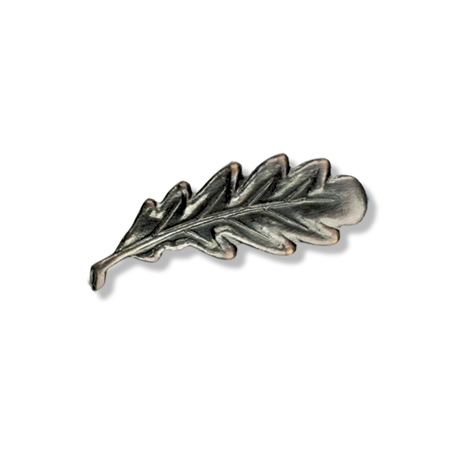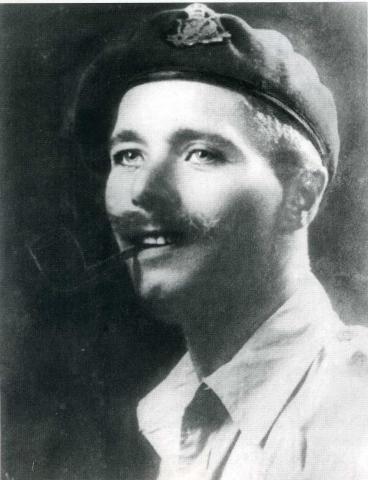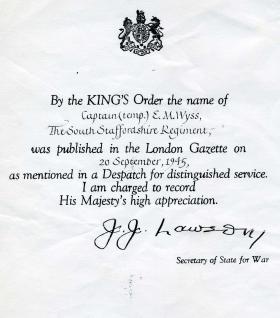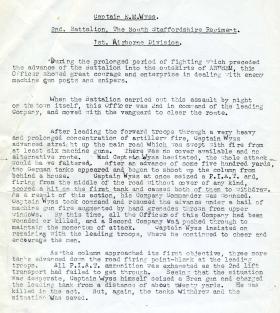Ernest Marcel Wyss was the son of Fritz Wyss (born 1888) and Florence Whittaker (born 1895), who had married in 1917. He was born on the 28th January 1919, and by 1921they were living at 31 South Street, Smallthorne, Staffordshire. By this time Fritz had changed his name to Frederick and he and his wife were running a Restaurant at 16 Market Place in Burslem, Staffordshire.
Ernest was educated from 1931 to 1935 at the Moseley Grammar School. By 1939 he was helping his parents in the Restaurant as a Caterers Assistant.
He was an only child until he was 22 years old, when in 1941 his mother gave birth to a daughter – Olga.
After attending the Royal Military Academy at Sandhurst, he was commissioned as a 2nd Lieutenant (Emergency Commission) on the 7 September 1940 with The South Staffordshire Regiment and posted to the 2nd Battalion, then stationed at St Albans, on the 14 September 1940. Here he became known by the nickname ‘Oscar’.
He was made a War Substantive Lieutenant on the 7 March 1942, and then on the 7 April 1943, he was promoted to Temporary Captain.
On the 3 August 1942 he was sent on a three week Airborne Division Battle Course, and appears to have remained there as a Battle school Instructor, not returning to his unit until the 30th January 1943. [1]
The Battalion departed for North Africa on the 16 May 1943, with ‘Oscar’ Wyss now the Second-in-Command of ‘C’ Company.
After considerable training, practice and rehearsals the 2nd Bn, The South Staffordshire Regiment, along with the rest of the 1st Airlanding Brigade was to take part in Operation ‘HUSKY’, the Allied invasion of Sicily. Accordingly the Brigade took off on the night of the 9th July 1943, to capture the Ponte Grande Bridge, just outside Syracuse – Operation ‘LADBROKE’. Capt. Wyss was in charge of a mixed group of 28 men, mainly formed of 18 Platoon, from ‘C’ Company, on board a Horsa glider, C/N: 135 that took off from ‘E’ airfield near M’Saken in Tunisia.
This is an extract from ‘By Land, Sea and Air’, page 42: ‘The last Horsa of C Company, C/N: 135, crash-landed six miles west of LZ 3. The 2i/c, Captain ‘Oscar’ Wyss, was wounded and had to stay behind in the care of his batman. The remainder, Company HQ and No. 18 Platoon, with their Platoon Commander Lieutenant Badger, left the glider and made their way to their objective. Lieutenant Badger was wounded in the hand, but was still able to lead his platoon. He reached the bridge the next day after fighting a few minor engagements en route. Captain Wyss and his batman were found by the Italians and taken prisoner, being held in the Floridia prison. They were released the following day when British forces reached the prison. During his short time in custody, Captain Wyss made friends with his other ‘criminal’ inmates and, when released, arranged for them to be ‘liberated’ as well.’
On 20 September 1943 he became Second in Command of D Company, 2nd Battalion South Staffs. Regiment, and at the end of November 1943 they returned back to England, arriving at Liverpool on the 10 December 1943 – just in time for leave at home for Christmas!
After many airborne operations had been planned, and just as swiftly cancelled, in September 1944 one of them finally took place – Operation ‘MARKET-GARDEN’ – the British plan to end the War before Christmas. As part of this the 1st Airborne Division was to capture the bridges over the Lower Rhine at Arnhem. The 2nd Bn, The South Staffordshire Regiment, however, would be split in half with part of Battalion HQ, part of Support Company and B and D Company’s going on the 1st Lift, and the balance of the Battalion on the 2nd Lift – which included C Company.
Capt. Wyss took off in a Horsa glider flown by glider pilots from B Squadron, from RAF Manston on Sunday, 17 September 1944, bound for LZ ‘S’ near Wolfheze in Holland, where he landed safely. The Battalion’s task was then to safe-guard LZ ‘S’ for the 2nd Lift, and D Company took up positions just to the North of Battalion H.Q. at Reijers Camp Farm. Before the arrival of the 2nd Lift, they were ordered to help with the attack by the 1st Parachute Brigade in Arnhem itself. They were to try and reach the 2nd Parachute Battalion, which was holding the North end of the main road bridge. With D Company leading the way, the Battalion set off at 10.30 hrs, Monday, 18 September, and after several skirmishes and at 20.00 hrs that night finally reach an area on the western outskirts of Arnhem.
The lead element of the 2nd Lift manage to join up with the rest of the Battalion later that night, and after a planning conference by Lieut-Colonel. McCardie with Lieut-Colonel. DT Dobie, of the 1st Parachute Battalion, it was decided that the 2nd Bn, The South Staffordshires will attack along the Bovenover (upper road – the Utrecthtseweg) towards the centre of Arnhem, with D Company leading, followed by B Company, then A Company, with C Company in reserve.
During this attack along the Utrechtseweg, which started at 04.30 hrs, Tuesday, 19th September, D Company suffered heavy casualties. An extract from ‘By Land, Sea and Air’, pages 107-108: ‘As No. 22 Platoon was by now virtually non-existent, No. 21 Platoon under Lieutenant J.J. MacDonald took over the lead, accompanied by the 2 i/c Captain EM ‘Oscar’ Wyss, who had taken over command after Major Phillp, the Company Commander, had been badly wounded in the stomach by machine-gun bullets. Private RCS Edwards, 21 Platoon, D Company: “We now came to a wide, exposed, riverside stretch of road in front of the St Elizabeth's Hospital and all hell seemed to let loose on us. We were out in the open and must have been like targets in a shooting gallery. All ‘Jerry’ had to do was line his guns and mortars along the gap, a quarter mile wide, and fire. He could not miss. Yet still Captain Wyss ran up and down, totally ignoring all the stuff and metal flying about him, his voice growing ever hoarser, ‘On, On, On, D Company On, On’, where men flagged, faltered or hesitated, he was there. You could not crawl on your stomach and watch him standing upright. You had to follow his lead. I laid what smoke bombs I had with me along the gap, where I thought they would do most good, then put my head down and ran like a harrier for the far side. I stumbled over the dead and dying, slithered in pools of blood, until I reached the partial shelter afforded by the houses and buildings. Here I found most of those that had got across the gap were sheltering in a dell by the side of the Museum.”’
Sgt Norman Howes, from A Company remembered: “We passed the Elizabeth Hospital - bodies and wounded behind every tree - 20mm and heavier fire from our right across the river. MG fire from our front and between buildings on our left. Not aware of any casualties until we reached the railing on the West perimeter of the Museum. It was dark and we were all crowded together - I would estimate, my Platoon; ‘A’ Coy HQ; Bn HQ; and some remnants of ‘D’ Coy. I was laying close beside my Platoon Handcart and Pte Montgomery. We were being laced by heavy MG fire. From conversations around me it appeared there were enemy tanks holding us up. I heard Lt Col McCardie shout out, ‘OSCAR, CAN YOU DO ANYTHING ABOUT THAT BLOODY TANK’. Now Oscar Wyss was a character - well liked and respected by all. He had a tremendous moustache and could NOT pronounce his ‘R’s’. He would ‘Wally’ the troops. He would criticize a man’s dirty ‘Wifle’. I heard Oscar shout out ‘WIGHT- HO! SIR’. I then heard a terrible burst of Spandau - just like ripping linen. I heard Oscar call out ‘Oh-Oh-Oh’ and then silence. I could not see his body but I would guess it was about 10 metres away. The Padre Capt Buchanan was to my left and he said to me ‘Cannot we go and help him?’ I replied ‘Sir, He’s dead’. My bravery was not as great as his Christianity.” [2]
Then on page 110-111 of ‘By Land, Sea and Air’: ‘Sergeant H. Dalton, No. 11 Platoon, B Company: “As I arrived at the Museum, I noticed a couple of my lads were wounded. Shortly after this some German tanks [SPG’s] came down the main road. Captain Wyss of D Company ordered me to find some PIAT bombs. I found a couple and handed them over to him. He then dashed down the corner firing at one of the tanks. I was going back to my Platoon, when the Padre shouted at me to help him get Captain Wyss into cover. We both dragged him off the road and, after examining him, found he was dead.”
Captain Ernest Marcel ‘Oscar’ Wyss was killed in action, attacking a self-propelled gun (SPG) with a Bren gun at a distance of only 20 yards, after his unit had exhausted their supply of PIAT ammunition. He was killed near the ‘museum area’, sometimes referred to as ‘The Monastery’.
In 1945, upon his release from POW Camp, Lieut-Colonel. McCardie wrote further Citations for some of his officers, who had not received any ‘recognition’ for their actions at Arnhem. He put Captain. Wyss forward for the Victoria Cross, but at Divisional level this was not approved. Instead he was awarded a Mention in Despatches, in September 1945, in recognition of his bravery throughout this operation: ‘During the prolonged period of fighting which preceded the advance of the Battalion into the outskirts of ARNHEM, this Officer showed great courage and enterprise in dealing with enemy machine gun posts and snipers.
When the Battalion carried out this assault by night on the town itself, this Officer was 2nd in command of the leading Company, and moved with the vanguard to clear the route.
After leading the forward troops through a very heavy and prolonged concentration of artillery fire, Captain Wyss advanced straight up the main road, which was swept with fire from at least six machine guns. There was no cover available and no alternative route. Had Captain Wyss hesitated, the whole attack would have faltered. After an advance of some five hundred yards, two German tanks [SPG’s] appeared and began to shoot up the column from behind a house. Captain Wyss at once seized a PIAT and, firing from the middle of the road without cover of any kind, scored a hit on the first tank and caused both of them to withdraw. As a result of this action, his Company Commander was wounded. Captain Wyss took command and resumed the advance under a hail of machine gun fire augmented by hand grenades thrown from upper windows. By this time, all the Officers of this Company had been wounded or killed, and a second Company was pushed through to maintain the momentum of attack. Captain Wyss insisted on remaining with the leading troops, where he continued to cheer and encourage the men.
As the column approached its first objective, three more tanks advanced down the road firing point-blank at the leading troops. All PIAT ammunition was exhausted as the 2nd Lift transport had failed to get through. Seeing that the situation was desperate, captain Wyss himself seized a Bren gun and charged the leading tank from a distance of about twenty yards. He was killed in the act. But, again, the tanks withdrew and the situation was saved.
Captain Wyss had been involved in close quarter fighting for nearly three hours. He was to be seen wherever the danger was greatest.
By his superb leadership, his prolonged heroism, and his complete disregard for his own life, this Officer, undoubtedly, saved the leading troops from suffering severe casualties on two separate occasions. His sacrifice of his own life enabled the battalion to consolidate the first objectives without further interference from enemy tanks’.
WDH McCardie.
Lieut-Colonel, Late Commanding 2nd Battalion, The South Staffordshire Regiment.
He was initially buried in the Moscowa General Cemetery at Arnhem as an unknown Captain of The South Staffordshire Regiment. The body in that grave was reburied in the Arnhem/Oosterbeek War Cemetery, in plot 15. C. 10, on the 27th August 1945. [3]
Positive identification that it was Captain. Ernest Marcel (‘Oscar’) Wyss finally took place in 1980, and the headstone was rededicated in 1986. [3]
NOTES:
[1] 2nd Bn, The South Staffordshire Regiment War Diary. August 1942 & January 1943.
[2] Letter from Norman Howes. 1996.
[3] Commonwealth War Grave Commission documents 1945 & 1986.
Images and information kindly donated by R. Hilton. Profile image from the book 'By Land, sea and Air' courtesy of Alex Junier.
Read More




Latest Comments
There are currently no comments for this content.
Add Comment
In order to add comments you must be registered with ParaData.
If you are currently a ParaData member please login.
If you are not currently a ParaData member but wish to get involved please register.